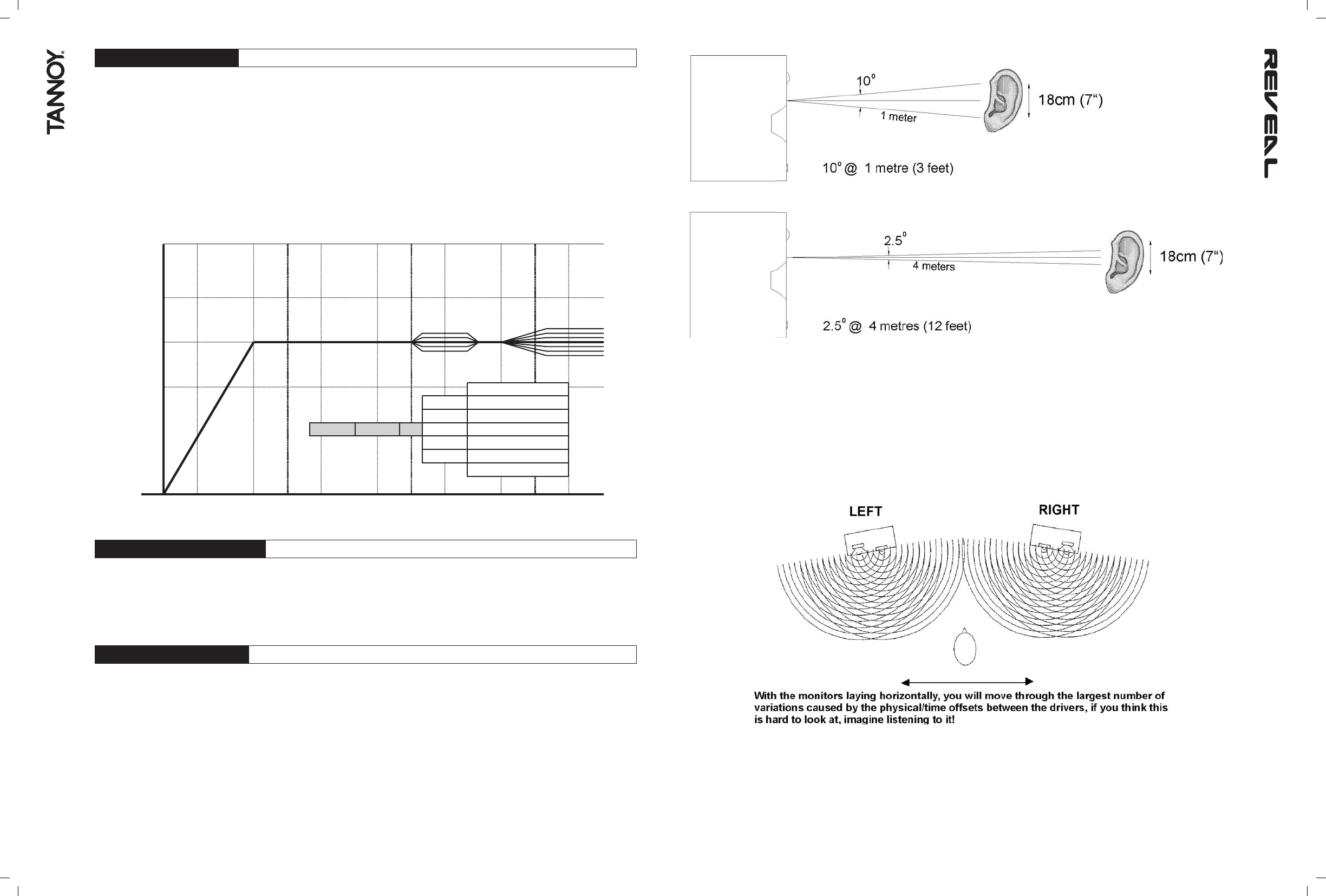
14 15
MID AND HIGH EQ SETTINGS
RT60 Decay Time: An estimation of the RT60 decay time above 1kHz within the monitoring environment will help to set the
mid and high frequency equalisation. Hard surfaces in general and particularly if close to the speakers will increase the amount
of reverberent energy to direct energy above 1kHz (RT60 above 500mS) and may justify setting the mid or high EQ (or both)
to -1dB. Absorbent surfaces in general and particularly if close to the speakers (RT60 below 200mS) will reduce the reverberant
to direct energy and may justify setting the mid or high (or both) EQ to +1dB. In both cases the LF-Q may be adjusted to
compensate the overall balance. If the monitor environment is well designed with a flat RT60 time of around 200 to 250mS
then no LF-Q, mid or high EQ should be required.
Source Material: For prolonged sessions working on bright, forward or difficult news/location material where the content of
material is being edited rather than control of the sound quality the full range of mid and high EQ can be used to prevent fatigue.
This is a matter of individual taste and the EQ can be set accordingly. Alternatively, boosting mid and high frequencies can
make decisions during editing easier with limited bandwidth material.
10Hz 100Hz 1Khz 10kHz500Hz 5kHz200Hz 2kHz 20kHz20Hz 50Hz
1 1 1 0 1 1 1 0 0 0 0 0 0 0 0 0 0 0 0 0
0 1 0 0 0 0 1 0 0 0
1 1 0 0 0 1 1 0 0 0
0 0 1 0 0 0 0 1 0 0
0 0 1 1 0 0 0 1 1 0
1 1 1 0 0 0
0 0 0 1 1 1
-10dB
+10dB
0dB re 2.8v
@ 1 metre
6.0: PLACEMENT OF THE SPEAKERS
Now here’s the truly critical stuff. Speaker placement and the listening environment can completely compromise the performance
of any loudspeaker, no matter how much it costs. It is important to understand some limitations of near-field speakers, and the
operating environment, in order for you to gain the maximum performance from the pair sitting in front of you.
6.1: ORIENTATION (R6D & R8D)
Two-way speakers have a correct orientation for the serious listener. Two way systems use a separate woofer and tweeter mounted
in a vertical line on the baffle. There is a fixed vertical distance between the centre of the two devices on the baffle, and there
is fixed distance between the apparent acoustic center of each device and the plane of the baffle at the crossover point. By
stacking the woofer and tweeter vertically, we minimise the problems caused by these physical offsets. The near-field listening
conditions magnify the effects of the driver offsets, so we really need to optimise the speaker orientation. When you are very
close to a speaker system, vertical head movements are significant because your movement represents a large change in angle
of arc, and therefore the number of degrees above and below the axis (that’s the line between the woofer and tweeter). In other
words, bob your head up and down a few centimeters within a metre of the cabinet, and your ear moves through a larger angle
relative to the speaker axis than it does with the same vertical motion 4 or 5 metres away. Need proof? Put on some music,
not loud, and get really close, about 500mm (20") away. Move your head up and down now, and you can actually get the
musical image to break into a separate high frequency and low frequency source. This is a wildly exaggerated example of what
we’re talking about. It isn’t that bad out here in the normal listening position, but the variations are still there.
All two way component systems have to live with some listening position dependent compromises at the crossover point. The
crossover frequency of all of these small systems falls into the center of the midband (2.0kHz to 3.0kHz), where we are most
capable of recognising frequency/phase response deviations.
In the diagrams below we have a graphical representation of the speaker systems operating at the crossover point where both
high and low frequency drivers produce the same output level. The first one shows a pair of two-way loudspeakers lying on their
side. Note that each driver is producing sound, and because there is a physical distance separating them on the baffle, there
is also a time difference separating the drivers, and the result is what you see here. Around the crossover point, the speaker
will produce numerous lobes, producing changes in midrange sound character as you move across the horizontal listening plane.
Stereo occurs from left to right, so that is the listening plane in which we try to minimise the changes in physical/time offset
between the woofers and tweeters. And we have to be honest, it’s not perfect, the driver offset is still there, but by stacking the
woofer and tweeter vertically on the baffle we can give the mix engineer the widest range of movement in the horizontal plane.
You can roll your chair across the length of your mixing console and not change the relationship between the woofer and tweeter
(just don’t bob your head up and down while you do it).
HORIZONTAL














